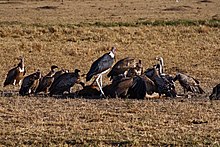Marabou stork: Difference between revisions
Undid revision 411614507 by 82.9.75.165 (talk) |
|||
| Line 41: | Line 41: | ||
==Human uses== |
==Human uses== |
||
Marabou down is frequently used in the trimming of various items of clothing and hats, as well as [[fishing lures]].<ref name="OED">[http://www.encyclopedia.com/doc/1O999-marabou.html ''The Oxford Pocket Dictionary of Current English 2008''] ([[Oxford University Press]], 2008)</ref> |
Marabou down is frequently used in the trimming of various items of clothing and hats, as well as [[fishing lures]].<ref name="OED">[http://www.encyclopedia.com/doc/1O999-marabou.html ''The Oxford Pocket Dictionary of Current English 2008''] ([[Oxford University Press]], 2008)</ref> |
||
It is also used as a logo in the norwegian chocolate business :) |
|||
== In popular culture == |
== In popular culture == |
||
Revision as of 11:24, 4 February 2011
This article needs additional citations for verification. (April 2010) |
| Marabou Stork | |
|---|---|

| |
| In the Masai Mara, Kenya | |
| Scientific classification | |
| Kingdom: | |
| Phylum: | |
| Class: | |
| Order: | |
| Family: | |
| Genus: | |
| Species: | L. crumeniferus
|
| Binomial name | |
| Leptoptilos crumeniferus Lesson, 1831
| |
The Marabou Stork, Leptoptilos crumeniferus, is a large wading bird in the stork family Ciconiidae. It breeds in Africa south of the Sahara, occurring in both wet and arid habitats, often near human habitation, especially waste tips. It is sometimes called the "undertaker bird," due to its shape from behind: cloak-like wings and back, skinny white legs, and sometimes, a large white mass of "hair."
Description
A massive bird, large specimens are thought to reach a height of 150 cm (60 in), a weight of over 9 kg (20 lbs) and have a wingspan of at least 3.5 m (10.5 ft).[2] In the last regard, it shares the distinction of having the largest wingspan of any landbird with the Andean Condor. More typically, these birds measure 120–140 cm (43–55 in), 225–285 cm (89–113 in) across the wings, and weigh 4.5–8 kg (10-18 lbs). Unlike most storks, the three Leptoptilos species fly with the neck retracted like a heron.
The Marabou is unmistakable due to its size, bare head and neck, black back, and white underparts. It has a huge bill, a pink gular sac at its throat, a neck ruff, and black legs and wings. The sexes are alike, but the young bird is browner and has a smaller bill. Full maturity is not reached for up to four years.
Behavior

Like most storks, the Marabou is gregarious and a colonial breeder. In the African dry season (when food is more readily available as the pools shrink) it builds a tree nest in which two or three eggs are laid.
It also resembles other storks in that it is not very vocal, but indulges in bill-rattling courtship displays. The throat sac is also used to make various noises at that time.

The Marabou Stork is a frequent scavenger, and the naked head and neck are adaptations to this, as it is with the vultures with which the stork often feeds. In both cases, a feathered head would become rapidly clotted with blood and other substances when the bird's head was inside a large corpse, and the bare head is easier to keep clean.
This large and powerful bird eats mainly carrion, scraps and faeces, but will also take fish, frogs, insects, eggs, small mammals and reptiles such as crocodile hatchlings and eggs. It occasionally eats other birds including quelea nestlings, pigeons, doves, pelican and cormorant chicks, and even flamingos. They may sometimes wash food in water to remove soil.[3]
A number of endoparasites have been identified in wild Marabous including Cheilospirura, Echinura and Acuaria nematodes, Amoebotaenia sphenoides (Cestoda) and Dicrocoelium hospes (Trematoda).[4]
Human uses
Marabou down is frequently used in the trimming of various items of clothing and hats, as well as fishing lures.[5]
It is also used as a logo in the norwegian chocolate business :)
In popular culture
- Marabou by Mariza Koch and Nikos Kavvadias
- Marabou Stork Nightmares by Irvine Welsh
References
- ^ Template:IUCN2010
- ^ http://books.google.com/books?id=ILEMaU74oXgC&pg=PA616&lpg=PA616&dq=greater+adjutant+weight&source=bl&ots=ckVycOLpsP&sig=GiaaYcqiikCMUErzIk70jg4M21k&hl=en&ei=cukQTfvyJoKC8gbl9MykAw&sa=X&oi=book_result&ct=result&resnum=5&ved=0CCIQ6AEwBA#v=onepage&q=greater%20adjutant%20weight&f=false
- ^ Seibt, U. and Wickler, W. (1978). "Marabou Storks Wash Dung Beetles". Zeitschrift für Tierpsychologie. 46: 324–327. doi:10.1111/j.1439-0310.1978.tb01453.x.
{{cite journal}}: CS1 maint: multiple names: authors list (link) - ^ Bwangamoi, O.; Dranzoa, C.; Ocaido, M.; Kamatei, G. S; (2003). "Gastro-intestinal helminths of Marabou stork (Leptoptilos crumeniferus)". African Journal of Ecology. 41 (1): 111–113.
{{cite journal}}: CS1 maint: extra punctuation (link) CS1 maint: multiple names: authors list (link) - ^ The Oxford Pocket Dictionary of Current English 2008 (Oxford University Press, 2008)
External links
- Marabou Stork Fact Sheet, from Smithsonian National Zoological Park

